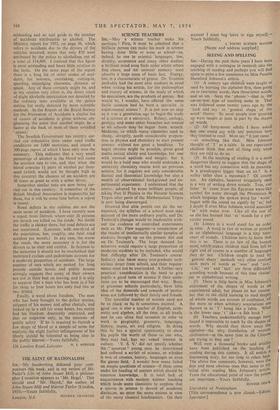SEEING AND SPELLING SIR,—During the past three years I have
been engaged with a colleague in research into the teaching of reading and perhaps you will find space to print a few comments on Miss Pamela Hansford Johnson's article.
(1) A century ago children were taught to read by learning the alphabet first, then going on to two-letter words, then three-letter words, and so on. Next the ' phonic '—that is, the cat-sat-mat type of teaching came in. That was followed some twenty years ago by the 'look and say' or 'general shape of the word' theory. So most people now growing up were taught at least in part by the shapes of words.
(2) Of forty-seven adults I have asked not one could say with any precision how, they learned to read. Most say "it just came" —or something like that. Miss Johnson thought of 'T' as a table. In our experience children think that sort of thing only when they are told to do so.
(3) In the teaching of reading it is a most dangerous theory to suggest that the shape of a word has any connection with its meaning. Is a grasshopper bigger than an ox ? Is 3 valley taller than a mountain ? Of course not. An alphabet, however irregularly used is a way of writing down sounds. True, our letter ' m ' came from the Egyptian wave-like symbol for water through the Phoenician hi, which language the spoken word for water' began with the sound we signify by ' m,' but 1 doubt if even Miss Johnson would associate `m' with water now. Like all the rest of us she has learned that m ' stands for a par- ticular sound.
(4) Letters in a word stand for an order in time. A word in fact as written or printed in an alphabetical language is a tiny time- chart of sounds. Children have to learn that this is so. There is no law of the human mind which makes children read from left to right and of course in a number of languages they do not. Children taught to read by general shape ' methods very often confuse such pairs of words as was' and saw.' Cat," act' and tact' are three differently sounding words because of this time charac- ter in alphabetical writing.
(5) There is little harm in Miss Johnson's enjoyment of the shapes of words as an
experienced adult, but please let her remem- ber that to the child learning to read shapes of whole words are sources of confusion, all the more so when arbitrary associations are thrown in as T ' being like a table. What is the lower case t' like—a fish hook ?
(6) Teachers understandably enough have found it impossible to teach by the shapes of words. Why should -they throw away the alphabet—the very foundation of western civilisation—at the same time as the Chinese are trying to find one ? Well over a thousand books and articles,
have been published on the teaching at reading during this century. It all makes a fascinating story, far too long to relate here' The above few comments, however, were the first and most obvious ones that came to MY mind after reading Miss Johnson's article. From the educational point of view the Points' are important.—Yours faithfully,










































 Previous page
Previous page